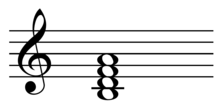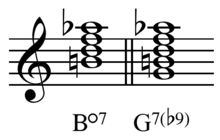- Seventh chord
-
A seventh chord is a chord consisting of a triad plus a note forming an interval of a seventh above the chord's root. When not otherwise specified, a "seventh chord" usually means a major triad with an added minor seventh (a dominant seventh chord). However, a variety of sevenths may be added to a variety of triads, resulting in many different types of seventh chords, as described below.
In its earliest usage, the seventh was introduced solely as an embellishing or nonchord tone. The seventh destabilized the triad, and allowed the composer to emphasize movement in a given direction. As time passed and the collective ears of the western world became more accustomed to dissonance, the seventh was allowed to become a part of the chord itself, and in some modern music, and jazz in particular, nearly every chord is a seventh chord. Additionally, the general acceptance of equal temperament during the 19th century reduced the dissonance of some earlier forms of sevenths.
Contents
Types of seventh chords
Most textbooks name these chords formally by the type of triad and type of seventh; hence, a chord consisting of a major triad and a minor seventh above the root is referred to as a major/minor seventh chord. When the triad type and seventh type are identical (i.e. they are both major, minor, or diminished), the name is shortened. For instance, a major/major seventh is generally referred to as a major seventh. This rule is not valid for augmented chords: since the augmented/augmented chord is not commonly used, the abbreviation augmented is used for augmented/minor, rather than augmented/augmented. Additionally, half-diminished stands for diminished/minor, and dominant stands for major/minor. When the type is not specified at all, the triad is assumed to be major, and the seventh is understood as a minor seventh (e.g. a "C" chord is a "C major triad", and a "C7" chord is a "C major/minor seventh chord", also known as a "C dominant seventh chord").
The most common chords are tertian, constructed using a sequence of major thirds (spanning 4 semitones) and/or minor thirds (3 semitones). Of the eight possible tertian seventh chords, seven are commonly found in western music:[2]
- Major seventh (formally major/major seventh, also maj7, M7, Δ, ⑦, etc.): root, major third, perfect fifth, major seventh
- Minor seventh (formally minor/minor seventh, also min7, m7,-7, etc.): root, minor third, perfect fifth, minor seventh
- Dominant seventh (formally major/minor seventh, commonly shortened to just "7", such as G7, or G7): root, major third, perfect fifth, minor seventh
- Diminished seventh (formally diminished/diminished seventh, also °7, or dim7): root, minor third, diminished fifth (tritone), diminished seventh (enharmonic major sixth)
- Half-diminished seventh (formally diminished/minor seventh, also known as "minor seventh flat five" among jazz musicians, denoted by m7♭5, -7♭5, ø, etc.): root, minor third, diminished fifth, minor seventh
- Minor major seventh (also mmaj7, mM7, mΔ7, -Δ7, m⑦, etc.): root, minor third, perfect fifth, major seventh
- Augmented major seventh (also maj7(♯5), +M7, +Δ7, etc.): root, major third, augmented fifth, major seventh
The following seventh chord is not tertian, as it is built using a sequence of two major thirds (4 semintones) and a diminished third (2 semitones, enharmonically equivalent to a major second):
- Augmented seventh (formally augmented/minor seventh, also aug7, +7, etc.): root, major third, augmented fifth, minor seventh
The following seventh chord is again not tertian, as it is built using a sequence of two minor thirds (3 semitones) and an augmented third (5 semitones, enharmonically equivalent to a perfect fourth):
- Diminished major seventh (also mM7♭5, -Δ7♭5, etc.): root, minor third, diminished fifth, major seventh
In tuning systems other than equal temperament there are further possible seventh chords. In just intonation, for example, there is the harmonic seventh.
Dominant seventh chord
Harmonic seventh chord
Main article: Harmonic seventh chordThe harmonic seventh chord is a dominant seventh chord formed by a major triad plus an harmonic seventh interval.
The harmonic seventh interval is a minor seventh tuned in the 7:4 pitch ratio, one of the possible "just ratios" defined for this interval in just intonation (slightly below the width of a minor seventh as tuned in equal temperament). Sometimes called a "blue note", the harmonic seventh is used by singers, through note bending on guitars, and on other instruments not restricted to equal temperament. An often heard example of the harmonic seventh chord is the last word of the modern addition to the song "Happy Birthday to You", with the lyrics, "and many more!" The harmony on the word "more" is typically sung as a harmonic seventh chord.[3]
Frequent use of the harmonic seventh chord is one of the defining characteristics of blues and barbershop harmony; barbershoppers refer to it as "the barbershop seventh." Since barbershop music tends to be sung in just intonation, the barbershop seventh chord may be accurately termed a harmonic seventh chord. The harmonic seventh chord is also widely used in "blues flavored" music. As guitars, pianos, and other equal-temperament instruments cannot play this chord, it is frequently approximated by a dominant seventh. As a result it is often called a dominant seventh chord and written with the same symbols (such as the blues progression I7 - V7 - IV7).
Major and minor seventh chords
While the dominant seventh chord is typically built on the fifth (or dominant) degree of a major scale, the minor seventh chord is built on the second, third, or sixth degree. A minor seventh chord contains the same notes as an added sixth chord. For example, C-E♭-G-B♭ can function as both a C minor seventh and an E flat added sixth (Id chord).
Major seventh chords are usually constructed on the first or fourth degree of a scale, (in C or G major: C-E-G-B). Due to the major seventh interval between the root and seventh (C-B, an inverted minor second), this chord can sometimes sound dissonant, depending on the voicing used. For example, Bacharach and David's Raindrops Keep Fallin' on My Head opens with a major chord followed by a major seventh in the next measure.
The major seventh is sometimes notated as Δ 7 (a delta chord) or just a Δ (which has the same meaning).
Half-diminished seventh chord
A half-diminished seventh chord is a seventh chord built from the seventh degree of a major scale. It's considered "half-diminished" because a fully diminished seventh has a double-flatted seventh, making it enharmonically the same as a major sixth. The half-diminished seventh chord uses a minor seventh over a diminished triad.
Diminished seventh chord
A diminished 7th chord is made of three superimposed minor 3rds (e.g. B-D-F-A♭), which is two tritones a minor third apart (e.g. B-F, D-A♭). The diminished 7th chord has been used by composers and musicians for a variety of reasons over time. Some reasons include: as a symbol of Sturm und Drang; modulation; and for characterisation. The diminished 7th chord is seen more frequently in late classical and romantic period works but is also found in Baroque and Renaissance period works, though not as frequently.
All of the elements of the Diminished 7th chord can be found in the Dominant 7th (b9) chord as seen in a comparison of the two chords.
Inversions
Seventh chord inversions are as follows:
- 7 — GBDF
 — BDFG
— BDFG
 — DFGB
— DFGB
 — FGBD
— FGBD
See also
References
- ^ Kostka & Payne (1995). Tonal Harmony, p.225. Third Edition. ISBN 0-07-300056-6.
- ^ The altered seventh chord (formally, augmented/augmented seventh chord), defined by a root, a major third, an augmented fifth, and an augmented seventh (i.e., a sequence of 3 major thirds), is a rarely used tertian seventh chord. The reason is that the augmented seventh interval is enharmonically equivalent to one entire octave (in equal temperament, 3 major thirds = 12 semitones = 1 octave) and is hence perfectly consonant with the chord root.
- ^ Mathieu, W.A. Harmonic Experience. Inner Traditions International; Rochester, Vermont; 1997. ISBN 0-89281-560-4, pg. 126
External links
- Tim Smith's 7th chord identification and construction drills in Javascript
- fretjam Guitar Theory - 7th Chords on Guitar
Chords By type Seventh- Ninth
- Eleventh
- Thirteenth
- Upper structure
- Sixth
- Minor sixth
- Augmented sixth
- Power chord
- Lydian chord
- Seven six chord
By function Secondary- Secondary dominant
- Secondary leading-tone
- Secondary supertonic
With names - Elektra chord
- Farben chord
- Hendrix chord
- Mu chord
- Mystic chord
- Northern lights chord
- Petrushka chord
- Power chord
- Psalms chord
- So What chord
- Spider chord
- Tristan chord
- Viennese trichord
- Dream chord
Other - Common chord (music)
- Mixed interval
- Open chord
- Polychord
- Primary triad
- Quartal and quintal
- Slash chord
- Subsidiary chord
- Synthetic chord
- Tone cluster
Categories:- Seventh chords
Wikimedia Foundation. 2010.








